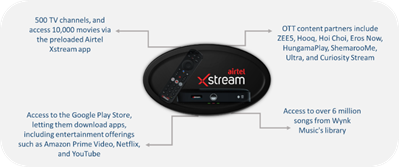Is ‘Content’ writing the new success story for Telcos?
Digitalization has changed the way people use to live, work, and enjoy, and this has forced business organizations to alter their business models to suit the requirements of their evolving consumers. The telecom industry is the one most impacted by this transformation. Telcos are experimenting with newer technologies, and service offerings to entice the demanding customer. The latest technologies though complex in nature, have higher accessibility, adaptability, and engagement among users. And one thing that has made this possible is the wider and deeper penetration of the telecom industry. Today almost 67% of the world population use mobile phones. A total of 3.8 billion use the internet, and 52% of that is on the 4G network. This has given people access to consume different types of content through the internet.
Changing the course
Telcos started offering value-added services to counter the falling revenue of voice and SMS. But the internet penetration has changed the landscape for the operators. As the telecom industry moves from being just a communication service provider towards a more complex organization that offers a bouquet of digital services, content is drafting a different story at all. Telcos are offering content through their platform in collaboration with disruptors like OTT players. The time people spent online has also significantly increased, with an average user spending 6.43 hours each day. More than 200 billion apps were downloaded in 2019, with a spending of $120 billion on apps and app-related purchases.
COVID-19 has also impacted the content consumption as consumers are making significant changes to the way they interact with content across platforms. This has drastically increased the time spent online watching content, especially news & entertainment. In fact, Nielsen’s report says that staying put in our homes can lead to almost a 60% increase in the amount of content we watch in some cases and potentially more depending on the reasons. The current situation will surely have a long term behavioral impact, and we may see similar consumption patterns going forward as well. This transformation has led operators to look content as a high potential business opportunity for now and for the future.
The Road of Experimentation
The new success story is built on the telecom industry’s direct to consumer strength. Telcos are venturing into adjacent industries or partnering with the content providers to explore new opportunities and keep the customers hooked to the service. T-Mobile acquired the television innovator Layer-3 to take on cable and satellite TV and revolutionize the way people consume TV. AT&T acquired Times Warner Inc. to offer customers a differentiated, high-quality, mobile-first entertainment experience. They have also launched AT&T TV that will be delivered over the internet as an alternative to the DirectTV to capture the sweet spot between streaming app users and traditional payTV service users such as cable or satellite TV. Just to give you a glimpse, it comes with an Android TV-powered box that lets you switch between live TV and over 5,000 apps from the Google Play Store without having to change inputs on your TV and access streaming apps such as Netflix, YouTube, Pandora, or Spotify right from their TV.
BT and Amazon signed an agreement to make the Prime video application available through BT’s TV set-top box. Telefónica has also integrated the video streaming app Netflix in its video and TV platforms in Latin America and Europe.
Airtel has also launched Airtel Xstream starting at USD11 (approx.) per month in India capture the interest of the larger consumer segment. Netflix has come up with a mobile-only plan for India that shows how demographic parameters will be of prime importance in your expansion strategy. Just imagine the scale and scope of service that are being offered to consumers and how complex it is to manage them in a seamless manner.
With 5G becoming mainstream, there will be further boosted in the service offering in terms of speed, variety, and experience. Media and entertainment as the prominent benefactor and allowing immersive media formats and applications like VR/AR and 360-degree videos, 5G promises a huge potential for Telcos content offering.
Looking for the Mojo
The opportunity has its own challenges for the telecom operators. Telcos need to plan a seamless experience for both their partners and end customers. This includes accessibility, uninterrupted service delivery, error-free payments and more to realize the true benefit of becoming a digital service provider. As the ecosystem becomes more complex, having a transparent and accurate content billing and settlement process can ensure profitability. Telcos should have the flexibility and scalability to build and test different rating and discounting models like minimum penetration, usage volume, minimum revenue commitment, A forecasting capability that will allow operators define the economic models for the services in future will go a long way. Although this is not the only challenge that they need to overcome. Identifying and onboarding right partners, capability to design dynamic economic models and monitoring partner performance and maintaining a transparent partnership can only ensure the success of the complex ecosystem.
Content settlement is not easy given the dynamicity of the service. A content billing solution that can address this dynamic and unique nature simultaneously enable trust and transparency in the ecosystem is the need of the hour. This can help operators to offer a truly out of the box digital content experience to its consumers.
Discover more on Content Billing and Settlement Solution of Subex.




